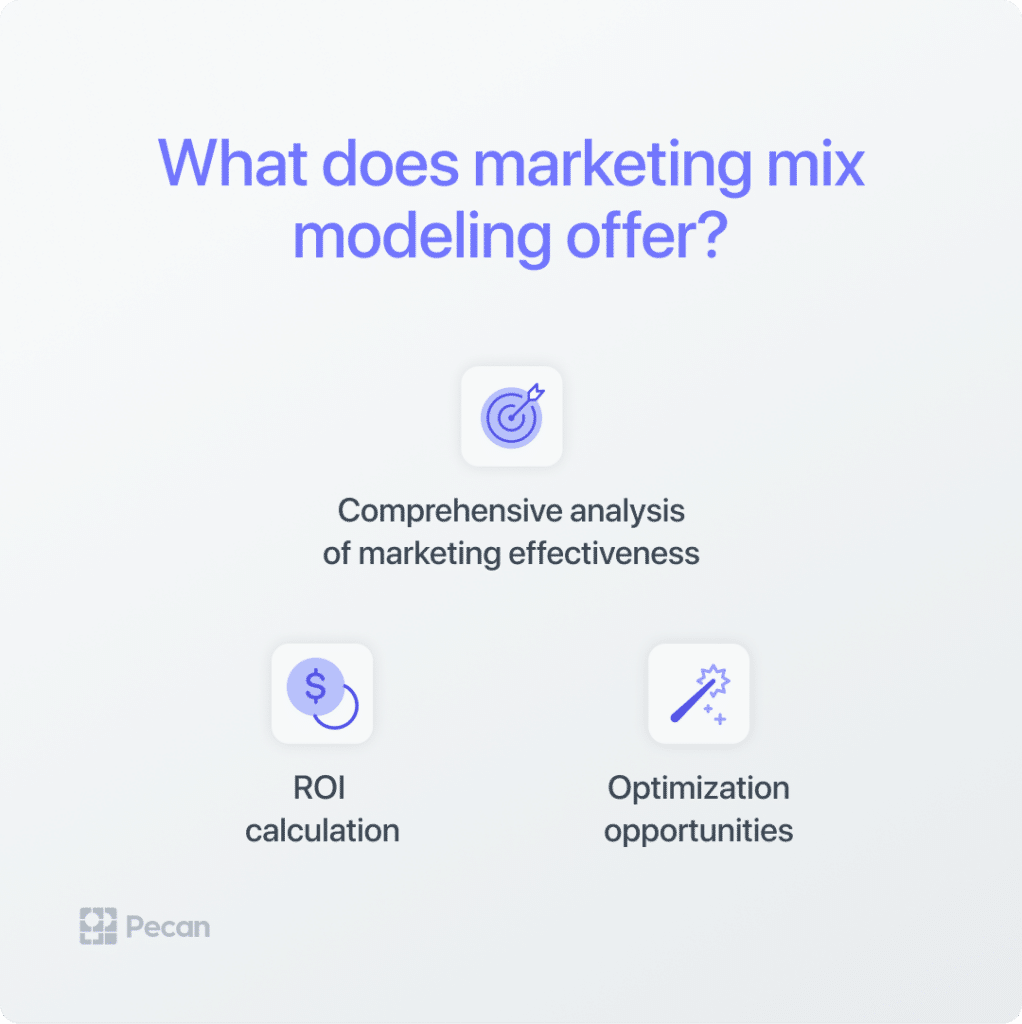In a nutshell:
- Even in the age of digital marketing, offline media (marketing channels) still have a strong role to play.
- Tracking offline marketing campaigns and their impact can be challenging.
- Marketing mix modeling (MMM) is a statistical analysis technique that helps measure the impact of offline and online channels on business performance.
- MMM allows for a comprehensive analysis of marketing effectiveness, ROI calculation, and optimization opportunities.
- Other methods for measuring offline channel performance include call tracking systems, unique coupon codes, QR codes, customer surveys, and social media interactions.
- Multi-touch attribution (MTA) and MMM provide valuable insights, but MMM offers a broader perspective on overall marketing effectiveness.
We all know digital marketing measurement isn’t perfect by any means. But tracking offline marketing campaigns and channels and their business impact can feel nearly impossible.
You may or may not have more marketing budget to play with right now. If you’re among the lucky 64 percent of marketers who expect a budget increase this year, that’s awesome. But you still need to make sure every bit of that increased budget provides real ROI.
And if you have the same or less budget, it’s time to make every penny work as efficiently as possible.
Let’s check out some ways to know if your offline pennies are getting the job done by reaching and converting your target audiences — just as well as you can track digital results.
What are offline media channels in marketing?
Think of the offline channels as those that pre-date the internet: print media, such as newspapers, magazines, television ads, and radio ads. Additionally, offline channels include direct mail campaigns, billboards, flyers, brochures, and physical storefronts.
Offline channels offer several advantages for marketers. First, they allow businesses to reach a broad audience, including individuals without internet access or who prefer traditional media.
Offline channels also provide a tangible and physical presence, enhancing brand recognition and credibility. Moreover, offline marketing can be highly targeted, allowing businesses to tailor their messages to specific geographic areas or demographics.
Additionally, offline marketing provides a break for consumers weary of digital ads. According to Hubspot research, 9 in 10 consumers feel ads are more intrusive today than a few years ago, and 87% feel there are generally just more ads. Notably, almost 8 in 10 feel they're being tracked by retargeting, which can be off-putting to some consumers. Despite the rise of digital marketing, offline channels play a significant role in reaching consumers.
What's an example of an offline media marketing strategy?
One example of an offline marketing strategy is direct mail marketing. Direct mail involves sending physical promotional materials, such as brochures, postcards, or catalogs, directly to a target audience's mailbox.
This strategy allows businesses to reach potential customers in a tangible and personal way, making it more likely for the recipient to engage with the marketing message.
Direct mail marketing can be highly targeted, allowing businesses to tailor their message to specific demographics or geographic areas. It also allows companies to include promotional offers or incentives.
Additionally, direct mail can be used with other offline marketing tactics, such as events or trade shows, to enhance brand awareness and engagement.
Is marketing in offline media still worth it?
In a world dominated by online marketing, it's natural to wonder if offline marketing still holds its ground. In addition to the benefits mentioned above, offline marketing can significantly enhance brand recognition and credibility. With physical channels, businesses establish themselves as beacons of trust and reliability in their industry.
In today's highly competitive landscape, where digital marketing dominates the industry, professionals must understand the value of incorporating traditional strategies into their overall approach.
Think about it: while digital marketing offers convenience and immediate results, traditional methods provide consumers with a tangible and memorable experience. It's like having a face-to-face conversation with someone instead of just texting them.
While online marketing may be the shiny new toy, offline marketing remains a force to be reckoned with.
Using offline media marketing to reach Gen Z efficiently
That can be especially true when engaging with Gen Z. For rthese younger consumers, offline marketing can create a unique and memorable brand experience. Here are some ways offline channels can reach younger consumers effectively:
- Experiential Marketing: Engage Gen Z consumers by meticulously curating immersive and interactive brand experiences, like events or pop-up shops.
- Print Media: Many younger consumers still appreciate print media and trust print ads. Strategically place captivating advertisements in highly regarded publications to seize their attention and leave a lasting impression.
- Community-Driven Initiatives: Support or orchestrate community events that seamlessly align with your brand's values, making a profound impact. Many Gen Z consumers seek socially responsible brands and find these efforts compelling.
Offline marketing efforts can appeal to younger audiences and create a lasting brand experience that resonates with this generation.
The limitations of offline marketing for your business
While tactics like print advertisements, billboards, and direct mail can effectively reach a local audience, they may not be enough to maximize your reach and impact.
Online marketing, on the other hand, offers endless possibilities. With online strategies, you can expand your reach and target specific demographics with precision.
Omnichannel: an omnichallenge
Odds are, you’re using a mix of channels to reach your audiences, just as they use a combination of channels to research purchases and shop. If you’re measuring only online marketing efforts, you’re left with an incomplete picture of overall marketing performance. (And, it’s worth noting that over half of marketers don’t feel great about their measurement of online marketing either.)
Ideally, you’d have a holistic evaluation that lets you accurately quantify the impact of both your online and offline channels on customer acquisition and revenue generation.
With that information, you can optimize budget allocation, ensuring resources are allocated to the most effective channels. This data-driven decision-making leads to more effective and efficient marketing strategies, driving higher customer acquisition and revenue growth.
Why is measuring offline channel performance difficult?
Offline marketing efforts can be challenging to measure due to the lack of direct attribution capabilities. Unlike online campaigns, offline marketing initiatives such as billboards or print advertisements don’t have built-in tracking mechanisms, making it challenging to directly attribute customer actions and conversions to specific offline touchpoints.
Additionally, sometimes offline and online channels’ effects interact with each other. Understanding how their interaction and shared influence contribute to marketing performance requires careful data analysis.
But don’t despair! There are still ways to measure the impact of offline marketing campaigns, such as utilizing marketing mix modeling, tracking website traffic and phone calls, conducting surveys, and using unique promo codes. Let’s dive into those methods now.
The benefits of marketing mix modeling
How does marketing mix modeling help with measuring offline channel performance?
Marketing mix modeling (MMM — also known as media mix modeling) is a statistical analysis technique that helps marketers assess the impact of various marketing channels and tactics on overall business performance.
It involves analyzing historical data to quantify the contribution of different marketing elements, including offline and online channels, to key performance indicators (KPIs) such as sales, revenue, or customer acquisition.
MMM includes a lot of factors, such as your marketing spend across all channels, market conditions, and even other external variables that might affect your business. All of those are used to build a comprehensive model that explains the relationship between marketing investments and business outcomes.
Some of the strengths of MMM include:
- Comprehensive analysis of marketing effectiveness: MMM allows for a holistic assessment of the performance of offline marketing campaigns by considering the interplay between various marketing channels, both online and offline. It provides a comprehensive view of how different touchpoints contribute to marketing effectiveness.
- ROI calculation: MMM enables businesses to precisely measure the success of their online and offline advertising campaigns. It helps marketing teams assess how much revenue and sales their marketing activities produce. Then, they can make better-informed decisions about where to allocate resources.
- Optimization opportunities: Through MMM, marketing managers can identify the most effective combinations of marketing channels and tactics. Resources can be shifted from underperforming channels to more successful offline and online initiatives, resulting in improved customer acquisition and higher returns.
With MMM’s help, you can make the most of your marketing budget — whether it’s more, less, or the same as in the past.
To start with MMM, you’ll need past data on promotions, sales, revenue, and other pertinent information. This information may originate from inside sources, such as sales data, advertisement costs, customer details, and outside sources like market research studies or industry research.
While it sounds incredibly complex, today’s machine-learning approaches have made using MMM far more accessible and faster than in the past, when only the largest companies could afford expert statisticians and technology to manage MMM.
Some companies choose to develop their own in-house MMM solutions, but this will still require the help of experienced data scientists and data engineering support.
Companies who don’t have that kind of expertise in-house may choose to use a software solution for MMM, which can also be more tightly integrated into the marketing team for greater impact and easier execution. While it can take some initial effort to pull together, partnering with a technology provider who has developed real, innovative approaches to MMM — and has the experience to make it work for you — can make this process far more straightforward and bring you the return on investment you want fast.
Once the model is developed, marketers can analyze results and gain insights into the performance of their offline marketing campaigns. They can evaluate the impact of different marketing channels, assess their ROI, see the effect of brand equity, identify optimization opportunities, and make data-driven decisions for future marketing strategies.
It would also be best to have intuitive simulation tools that use the model to make planning future marketing budgets far easier and streamlined.
How can you use customer information to gather data on offline marketing channel performance?
There are other ways to track your offline marketing channels’ performance, but they may or may not be as trustworthy and accurate as you would like. Here are some methods for gathering data on how customers have found you through offline marketing channels:
- Call tracking systems: Offline marketing campaigns often include phone numbers as a call-to-action, such as in print ads or billboards. Call tracking systems assign unique phone numbers to different marketing campaigns or channels. When a customer calls a specific phone number, the system captures data such as the caller’s phone number, call duration, and call recording (if applicable). These systems use advanced analytics and reporting capabilities to provide detailed insights into call volumes, sources, outcomes, and customer behavior. By capturing call data in a CRM system, marketing managers can track customer touchpoints, attribute conversions, and gain insights into the customer journey from initial call to final purchase or desired action.
- Unique coupon codes: Coupon codes allow marketers to attribute conversions to specific promotions or touchpoints. By providing customers with unique codes associated with offline campaigns, digital marketing managers can identify which campaigns drive coupon code usage, customer engagement, and conversions. Online and offline integration can be achieved by promoting discount codes through offline channels and requiring customers to enter them during online purchases, allowing cross-channel tracking and attribution. QR codes and custom landing pages offer similar possibilities for tracking customer interactions with offline marketing campaigns. Each scan provides measurable data on customer engagement and conversions.
- Customer surveys and feedback: Surveys provide direct feedback from customers regarding their interactions with offline marketing campaigns, enabling businesses to measure customer sentiment, recall, and overall campaign effectiveness. You might gather in-store feedback if you have brick-and-mortar locations or comments from attendees of an event.
And, of course, social media interactions and review sites offer different insights into customer experiences. Ideally, you can use a combination of these insights to make data-driven decisions, optimize strategies, and enhance customer acquisition efforts.
While these methods of looking at customers’ interactions with your offline marketing channels can provide valuable insights, looking at the data from each of them individually doesn’t give the same holistic perspective that MMM offers. It’s great to know how many customers converted with a specific coupon code or by calling a specific number. However, you won’t know whether the conversion was potentially influenced by the interaction of multiple campaigns across various channels or by general brand awareness activities you might also be pursuing.
Despite all the individual data sources available to you for offline marketing (such as they are), the comprehensive viewpoint provided by a reliable MMM model is irreplaceable.
MMM can help you measure offline marketing channels' performance.
But what about multi-touch attribution? How do MTA and MMM relate to each other?
Multi-touch attribution (MTA) and MMM try to understand the contribution of all your marketing efforts to your ultimate outcomes. However, they do that in fundamentally different ways.
MTA aims to attribute the value or impact of marketing touchpoints across the customer journey. It considers the entire customer journey, from initial touchpoints to the final conversion or purchase. In the context of measuring offline marketing channels, multi-touch attribution helps identify and quantify the role of offline touchpoints in driving conversions or sales.
For example, if a customer sees an offline advertisement, visits a store, and then purchases online, multi-touch attribution would assign value to both the offline and online touchpoints in the conversion process. Marketers can choose different models, like time-decay or last-touch, to give appropriate credit to each touchpoint. Then, digital marketing managers can identify the high-performing touchpoints, optimize marketing strategies, reallocate resources, and make data-driven decisions to improve customer acquisition and ROI.
However, MTA is complex, and choosing the right modeling approach can be tricky. Implementing multi-touch attribution requires careful consideration and ongoing evaluation to ensure accurate and meaningful insights for optimizing marketing efforts.
On the other hand, MMM uses regression models to analyze historical data and determine the relationship between marketing inputs and desired outcomes. MMM can incorporate multi-touch attribution by considering the aggregated impact of all online and offline marketing touchpoints on the target KPIs.
While multi-touch attribution focuses on attributing credit to specific touchpoints, MMM takes a broader approach by assessing the overall effectiveness of marketing channels and their combined impact.
To understand offline campaigns’ performance, MMM can help measure the contribution of different offline channels to sales or other KPIs, considering their interactions with online touchpoints. By analyzing historical data and applying statistical modeling, MMM can provide insights into the effectiveness, ROI, and optimal allocation of resources across various marketing channels, including offline channels.
Both multi-touch attribution and MMM provide valuable insights, but the critical value of MMM is gaining that broader perspective. A marketer with an accurate MMM model can genuinely grasp the overall effectiveness of all marketing channels, online and offline, and their combined influence on business outcomes.
If you’d like to explore how MMM can complete your marketing measurement strategy — for online and offline channels together — get in touch to talk about how to get started today.








